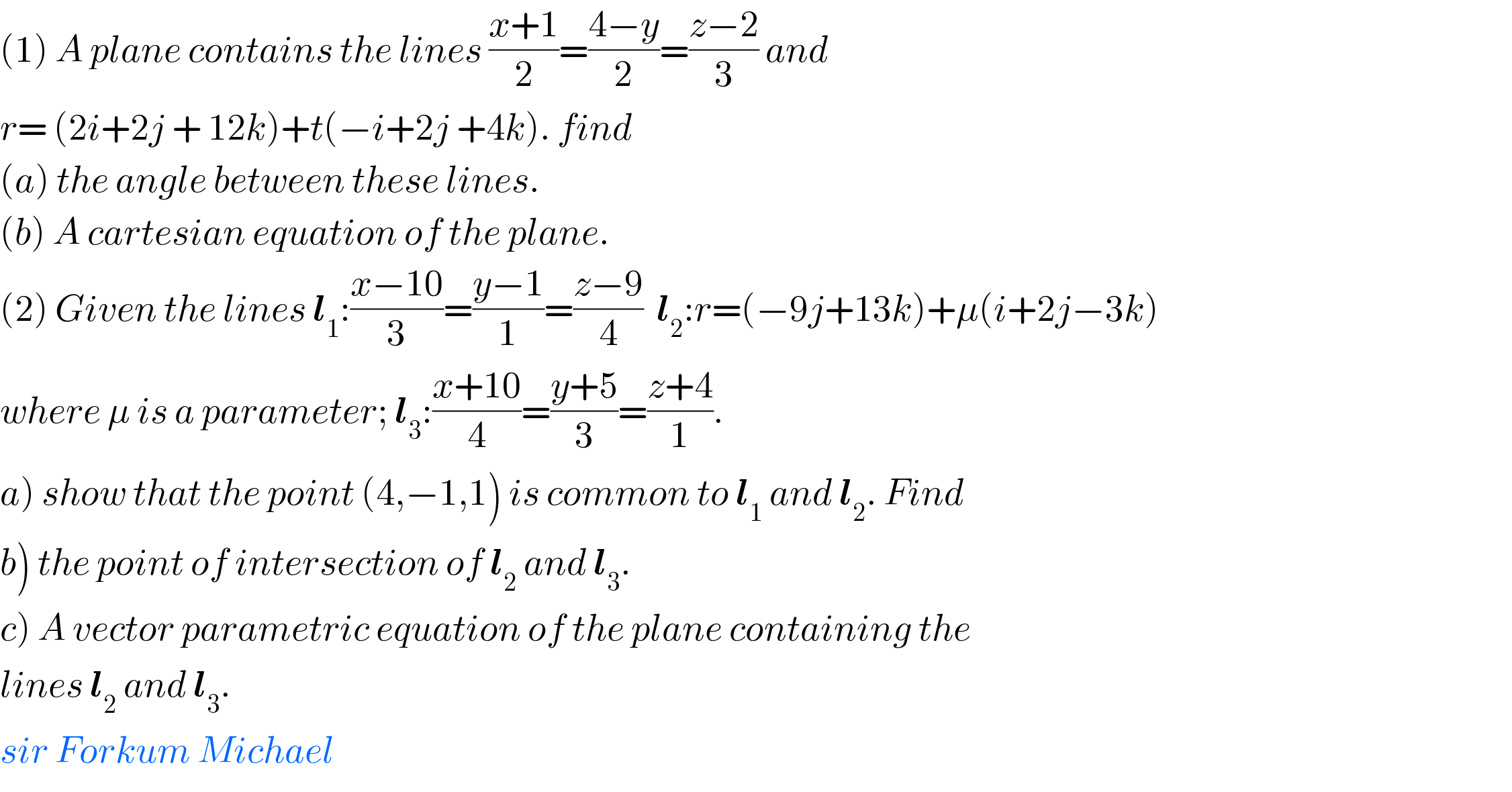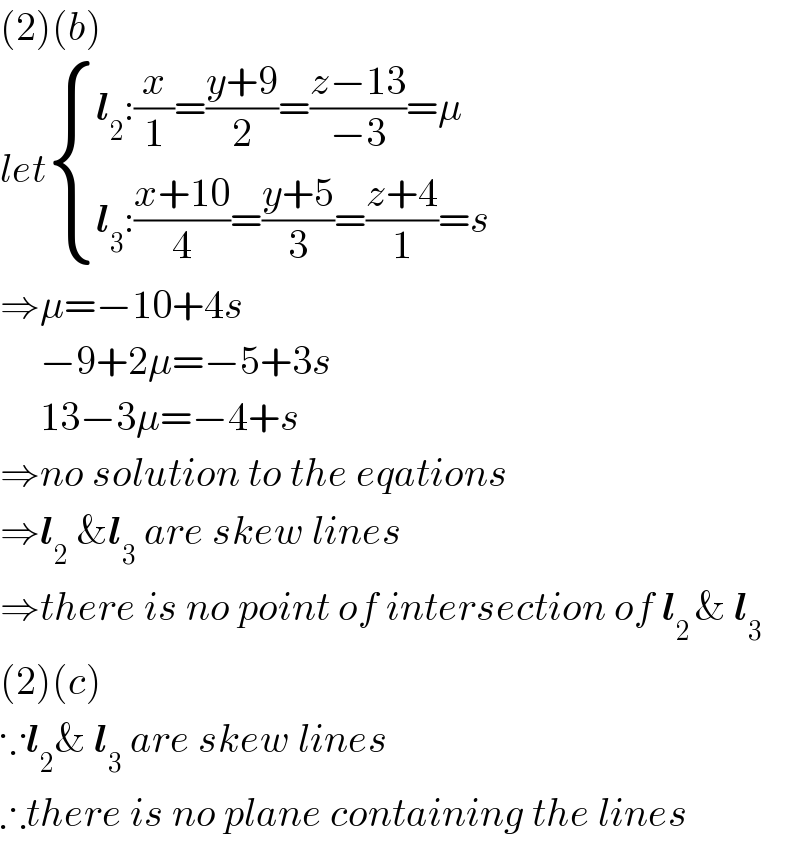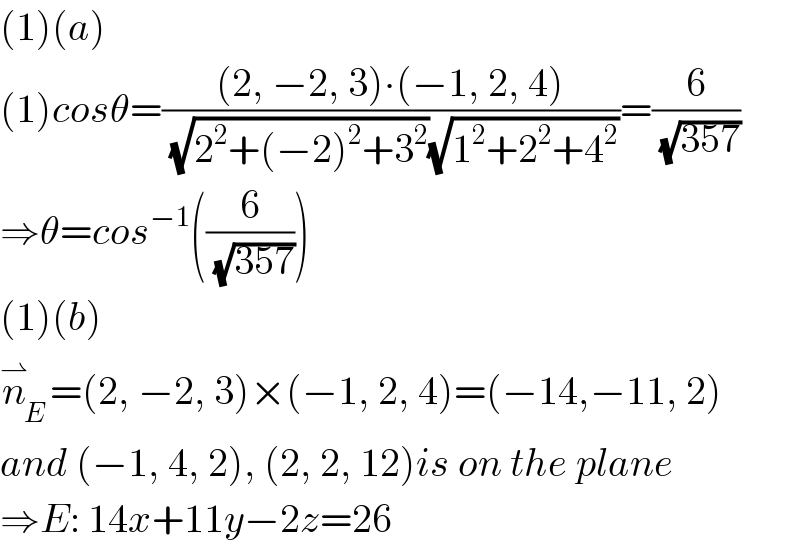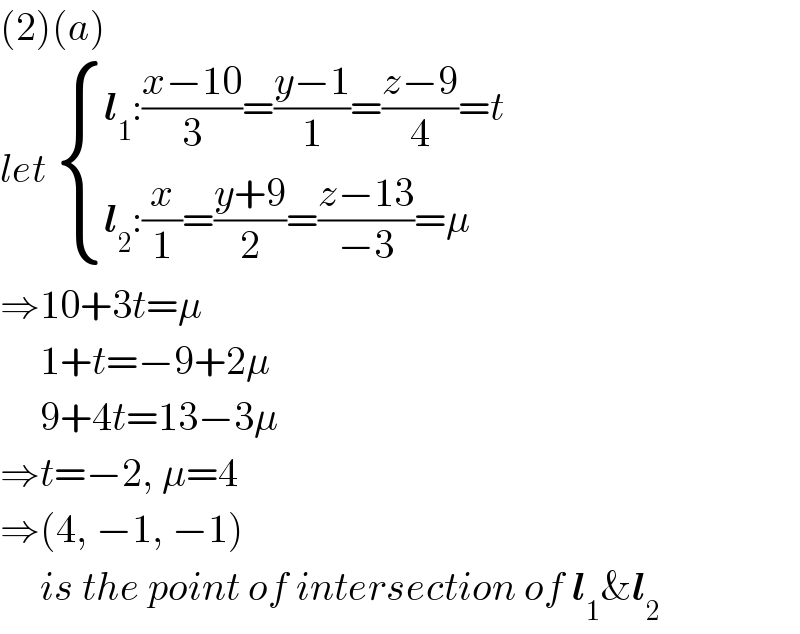
Question Number 63427 by Rio Michael last updated on 04/Jul/19

$$\left(\mathrm{1}\right)\:{A}\:{plane}\:{contains}\:{the}\:{lines}\:\frac{{x}+\mathrm{1}}{\mathrm{2}}=\frac{\mathrm{4}−{y}}{\mathrm{2}}=\frac{{z}−\mathrm{2}}{\mathrm{3}}\:{and}\: \\ $$$${r}=\:\left(\mathrm{2}{i}+\mathrm{2}{j}\:+\:\mathrm{12}{k}\right)+{t}\left(−{i}+\mathrm{2}{j}\:+\mathrm{4}{k}\right).\:{find} \\ $$$$\left({a}\right)\:{the}\:{angle}\:{between}\:{these}\:{lines}. \\ $$$$\left({b}\right)\:{A}\:{cartesian}\:{equation}\:{of}\:{the}\:{plane}. \\ $$$$\left(\mathrm{2}\right)\:{Given}\:{the}\:{lines}\:\boldsymbol{{l}}_{\mathrm{1}} :\frac{{x}−\mathrm{10}}{\mathrm{3}}=\frac{{y}−\mathrm{1}}{\mathrm{1}}=\frac{{z}−\mathrm{9}}{\mathrm{4}}\:\:\boldsymbol{{l}}_{\mathrm{2}} :{r}=\left(−\mathrm{9}{j}+\mathrm{13}{k}\right)+\mu\left({i}+\mathrm{2}{j}−\mathrm{3}{k}\right) \\ $$$${where}\:\mu\:{is}\:{a}\:{parameter};\:\boldsymbol{{l}}_{\mathrm{3}} :\frac{{x}+\mathrm{10}}{\mathrm{4}}=\frac{{y}+\mathrm{5}}{\mathrm{3}}=\frac{{z}+\mathrm{4}}{\mathrm{1}}. \\ $$$$\left.{a}\right)\:{show}\:{that}\:{the}\:{point}\:\left(\mathrm{4},−\mathrm{1},\mathrm{1}\right)\:{is}\:{common}\:{to}\:\boldsymbol{{l}}_{\mathrm{1}} \:{and}\:\boldsymbol{{l}}_{\mathrm{2}} .\:{Find} \\ $$$$\left.{b}\right)\:{the}\:{point}\:{of}\:{intersection}\:{of}\:\boldsymbol{{l}}_{\mathrm{2}} \:{and}\:\boldsymbol{{l}}_{\mathrm{3}} . \\ $$$$\left.{c}\right)\:{A}\:{vector}\:{parametric}\:{equation}\:{of}\:{the}\:{plane}\:{containing}\:{the} \\ $$$${lines}\:\boldsymbol{{l}}_{\mathrm{2}} \:{and}\:\boldsymbol{{l}}_{\mathrm{3}} . \\ $$$${sir}\:{Forkum}\:{Michael} \\ $$
Commented by Tony Lin last updated on 04/Jul/19

$$\left(\mathrm{2}\right)\left({b}\right) \\ $$$${let\begin{cases}{\boldsymbol{{l}}_{\mathrm{2}} :\frac{{x}}{\mathrm{1}}=\frac{{y}+\mathrm{9}}{\mathrm{2}}=\frac{{z}−\mathrm{13}}{−\mathrm{3}}=\mu}\\{\boldsymbol{{l}}_{\mathrm{3}} :\frac{{x}+\mathrm{10}}{\mathrm{4}}=\frac{{y}+\mathrm{5}}{\mathrm{3}}=\frac{{z}+\mathrm{4}}{\mathrm{1}}={s}}\end{cases}} \\ $$$$\Rightarrow\mu=−\mathrm{10}+\mathrm{4}{s} \\ $$$$\:\:\:\:\:−\mathrm{9}+\mathrm{2}\mu=−\mathrm{5}+\mathrm{3}{s} \\ $$$$\:\:\:\:\:\mathrm{13}−\mathrm{3}\mu=−\mathrm{4}+{s} \\ $$$$\Rightarrow{no}\:{solution}\:{to}\:{the}\:{eqations} \\ $$$$\Rightarrow\boldsymbol{{l}}_{\mathrm{2}} \:\&\boldsymbol{{l}}_{\mathrm{3}} \:{are}\:{skew}\:{lines} \\ $$$$\Rightarrow{there}\:{is}\:{no}\:{point}\:{of}\:{intersection}\:{of}\:\boldsymbol{{l}}_{\mathrm{2}\:} \&\:\boldsymbol{{l}}_{\mathrm{3}} \\ $$$$\left(\mathrm{2}\right)\left({c}\right) \\ $$$$\because\boldsymbol{{l}}_{\mathrm{2}} \&\:\boldsymbol{{l}}_{\mathrm{3}} \:{are}\:{skew}\:{lines} \\ $$$$\therefore{there}\:{is}\:{no}\:{plane}\:{containing}\:{the}\:{lines} \\ $$
Commented by Tony Lin last updated on 04/Jul/19

$$\left(\mathrm{1}\right)\left({a}\right) \\ $$$$\left(\mathrm{1}\right){cos}\theta=\frac{\left(\mathrm{2},\:−\mathrm{2},\:\mathrm{3}\right)\centerdot\left(−\mathrm{1},\:\mathrm{2},\:\mathrm{4}\right)}{\sqrt{\mathrm{2}^{\mathrm{2}} +\left(−\mathrm{2}\right)^{\mathrm{2}} +\mathrm{3}^{\mathrm{2}} }\sqrt{\mathrm{1}^{\mathrm{2}} +\mathrm{2}^{\mathrm{2}} +\mathrm{4}^{\mathrm{2}} }}=\frac{\mathrm{6}}{\sqrt{\mathrm{357}}} \\ $$$$\Rightarrow\theta={cos}^{−\mathrm{1}} \left(\frac{\mathrm{6}}{\sqrt{\mathrm{357}}}\right) \\ $$$$\left(\mathrm{1}\right)\left({b}\right) \\ $$$$\overset{\rightharpoonup} {{n}}_{{E}} =\left(\mathrm{2},\:−\mathrm{2},\:\mathrm{3}\right)×\left(−\mathrm{1},\:\mathrm{2},\:\mathrm{4}\right)=\left(−\mathrm{14},−\mathrm{11},\:\mathrm{2}\right) \\ $$$${and}\:\left(−\mathrm{1},\:\mathrm{4},\:\mathrm{2}\right),\:\left(\mathrm{2},\:\mathrm{2},\:\mathrm{12}\right){is}\:{on}\:{the}\:{plane} \\ $$$$\Rightarrow{E}:\:\mathrm{14}{x}+\mathrm{11}{y}−\mathrm{2}{z}=\mathrm{26} \\ $$
Commented by Tony Lin last updated on 04/Jul/19

$$\left(\mathrm{2}\right)\left({a}\right) \\ $$$${let}\:\begin{cases}{\boldsymbol{{l}}_{\mathrm{1}} :\frac{{x}−\mathrm{10}}{\mathrm{3}}=\frac{{y}−\mathrm{1}}{\mathrm{1}}=\frac{{z}−\mathrm{9}}{\mathrm{4}}={t}}\\{\boldsymbol{{l}}_{\mathrm{2}} :\frac{{x}}{\mathrm{1}}=\frac{{y}+\mathrm{9}}{\mathrm{2}}=\frac{{z}−\mathrm{13}}{−\mathrm{3}}=\mu}\end{cases} \\ $$$$\Rightarrow\mathrm{10}+\mathrm{3}{t}=\mu \\ $$$$\:\:\:\:\:\mathrm{1}+{t}=−\mathrm{9}+\mathrm{2}\mu \\ $$$$\:\:\:\:\:\mathrm{9}+\mathrm{4}{t}=\mathrm{13}−\mathrm{3}\mu \\ $$$$\Rightarrow{t}=−\mathrm{2},\:\mu=\mathrm{4} \\ $$$$\Rightarrow\left(\mathrm{4},\:−\mathrm{1},\:−\mathrm{1}\right) \\ $$$$\:\:\:\:\:{is}\:{the}\:{point}\:{of}\:{intersection}\:{of}\:\boldsymbol{{l}}_{\mathrm{1}} \&\boldsymbol{{l}}_{\mathrm{2}} \\ $$
Commented by Rio Michael last updated on 04/Jul/19

$${perfect}.\: \\ $$
